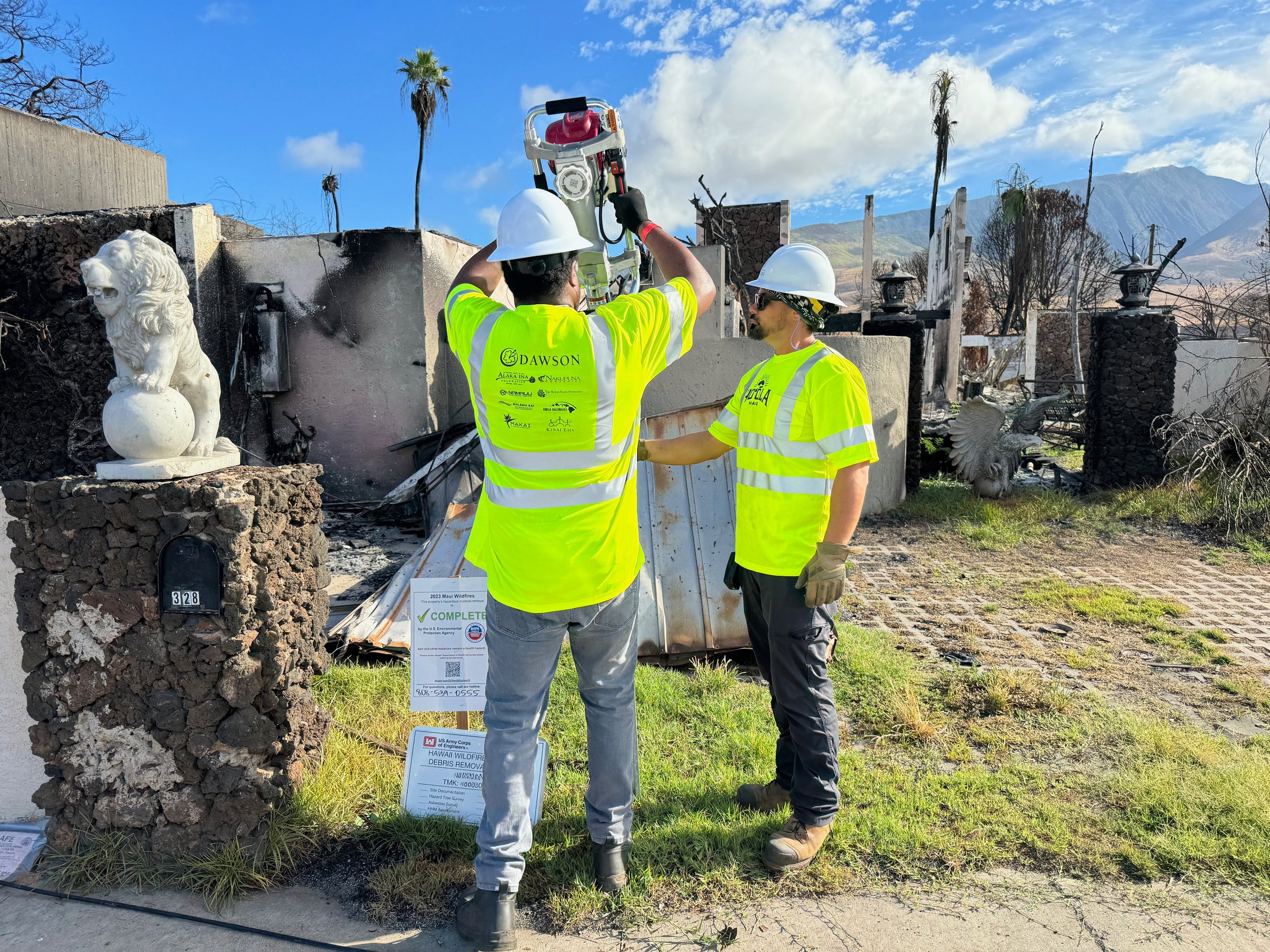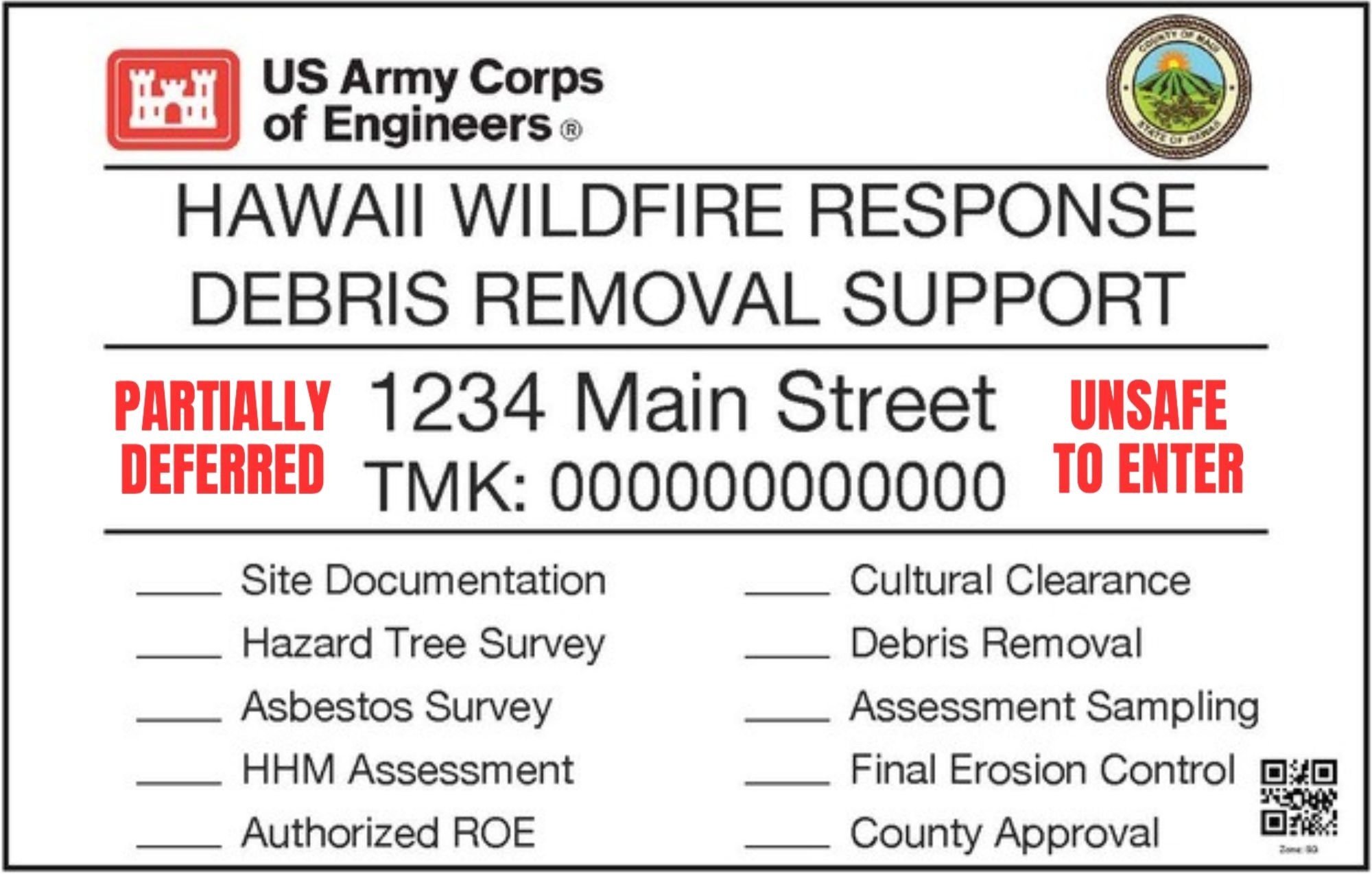What are the checklist items on USACE property signs?
What’s on the new signs being posted on impacted properties? On behalf of the U.S. Army Corps of Engineers (USACE), when DAWSON and partner Hoʻōla Maui member organization teams get started in each zone of the affected areas, the first task is to post signage on each property. Each sign shows the property address and has a checklist of steps U.S. Army Corps of Engineers contractors will mark off as tasks are completed.
Every impacted property is marked with this sign to document each step of the clean-up process.
These signs provide a useful snapshot of progress on each property. It is helpful to understand each item, and who is responsible for annotating the progress under USACE’s direction. When you see a sign on a property, you will be able to know what tasks have been completed and what debris removal work will be taking place in the coming days.
Here, we'll break down each step including responsibilities and specific actions for the items on the checklist. To find out the status of your individual property, visit the USACE Hawaiʻi Wildfire Site Debris Removal Status Lookup Tool.
Workers from Hoʻōla Maui NHO member Kinai ʻEha install a sign.
Site Documentation
Who’s doing the work: DAWSON, along with Hoʻōla Maui NHO members Nakupuna, Krilla Kaleiwahea, and Kinai ʻEha (sign installation and quality control), and Hoʻōla Maui partner DebrisTech (data collection)
What’s involved: Site survey teams cross reference the Tax Map Key (TMK) numbers, addresses, and a GIS-based mapping system to ensure each individual property is correctly identified.
Hazard Tree Survey
Who’s doing the work: DAWSON, along with Hoʻōla Maui NHO partners Forgen, Kane’s Legacy Tree Services, and ClimbingHI (arborists)
What’s involved: Trained arborists assess trees affected by the wildfires to determine which ones present a possible hazard or will be unable to regrow safely, and which are healthy enough to survive for at least another 4-5 years. The trees are marked for preservation or removal accordingly. Learn more about the process here.
Asbestos Survey
Who’s doing the work: DAWSON and Hoʻōla Maui NHO partner Environmental Risk Analysis (testing)
What’s involved: A trained asbestos inspector evaluates properties. If asbestos contaminated materials are identified, samples are tested to confirm the contamination. Specific contaminated materials are then marked for special handling as hazardous material, and in some cases, removed prior to the next phase of cleanup work.
HHM Assessment
Who’s doing the work: DAWSON and Hoʻōla Maui NHO members Nakupuna, Krilla Kaleiwahea, and Kinai ʻEha (site assessments) with Hoʻōla Maui partners Forgen (site assessments and data collection) and Unitek (removal for materials of concern)
What’s involved: Household Hazardous Waste or Materials (HHM) are common household materials that are flammable, corrosive, or toxic. Examples could include gas cans, propane bottles, paint cans, aerosol cans, batteries, or lithium batteries. These materials are removed by a trained group of hazardous materials specialists, containerized, and transported to a safe holding area for further processing.
Authorized ROE
Who’s doing the work: County of Maui
What’s involved: Collecting and processing Right of Entry (ROE) permits to send to USACE. The ROE gives USACE and their contractors the property owner’s permission to enter the property. Neither USACE nor their contractors can assess or remove debris from a property without this permission from the homeowner. Learn more about the process here.
Cultural Clearance
Who’s doing the work: AEPAC (USACE’s prime contractor for cultural monitoring during the current phase of work)
What’s involved: The cultural team will assess the property during DAWSON site assessments to determine if there are significant cultural items on the site.
Debris Removal
Who’s doing the work: ECC inc. (USACE’s Advanced Contracting Initiative program contractor for the next phase of the private property debris removal)
What’s involved: Trained teams will remove debris from each property, including categories like concrete, including foundations; metal, including any vehicles; ash and debris; and the top few inches of contaminated soil, taking as much care as possible to avoid any unnecessary impact to important cultural and historic sites.
Assessment Sampling
Who’s doing the work: ECC inc.
What’s involved: Once the debris and soil impacted by ash has been cleared, teams will sample the soil under the ash footprint to ensure that the contaminants are within the safety guidelines, as defined by the appropriate regulatory authorities, to be ready to rebuild.
Final Erosion Control
Who’s doing the work: ECC inc.
What’s involved: Teams install stormwater and erosion control materials at each site to stabilize the soil from being washed away by rainwater or weather events until plants can begin to regrow and sites can be rebuilt.
County Approval
Who’s doing the work: Maui County
What’s involved: Once all the previous steps are completed and signed off, the County of Maui will issue a final approval and the property can be released back to the owners.
Unsafe to enter?
As the stability of structures in the affected area degrades, a small number of residential properties have been recently deemed unsafe to enter. Hoʻōla Maui work crews, under prime contractor DAWSON, have placed red stickers on these property signs of those properties to call attention to the critical safety hazard. The red stickers on the property signs look like this:
An example of a critical safety hazard could be a wall that is likely to collapse in the entryway of the site, making it dangerous for crews and property owners to enter.
For more information, check out our recent project update on the ‘unsafe to enter’ designation.



